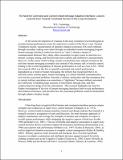The Need for Command and Control Instant Message Adaptive Interfaces: Lessons Learned from Tactical Tomahawk Human-in-the-Loop Simulations
Author(s)
Cummings, M. L.
DownloadDraft version (233.4Kb)
Metadata
Show full item recordAbstract
In the recent development of a human-in-the-loop simulation test bed designed to examine human performance issues for supervisory control of the Navy’s new Tactical Tomahawk missile, measurements of operator situation awareness (SA) and workload through secondary tasking were taken through an embedded instant messaging program. Instant message interfaces (otherwise known as “chat”), already a means of communication between Navy ships, allow researchers to query users in real-time in a
natural, ecologic setting, and thus provide more realistic and unobtrusive measurements. However, in the course of this testing, results revealed that some subjects fixated on the real-time instant messaging secondary task instead of the primary task of missile control, leading to the overall degradation of mission performance as well as a loss of SA. While
this research effort was the first to quantify command and control performance degradation as a result of instant messaging, the military has recognized that in its network centric warfare quest, instant messaging is a critical informal communication tool, but has associated problems. Recently a military spokesman said that managing chat in current military operations was sometimes a “nightmare” because military personnel have difficulty in handling large amounts of information through chat, and then synthesizing knowledge from this information. This research highlights the need for
further investigation of the role of instant messaging interfaces both on task performance and situation awareness, and specifies how the associated problems could be ameliorated through adaptive display design.
Date issued
2004Publisher
CyberPsychology and Behavior
Citation
Cummings, M.L., The Need for Command and Control Instant Message Adaptive Interfaces: Lessons Learned from Tactical Tomahawk Human-in-the-Loop Simulations published by invitation in CyberPsychology and Behavior Vol. 7(6), 2004.
Keywords
human-in-the-loop, supervisory control